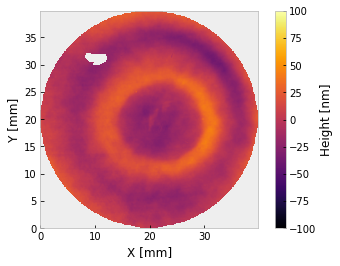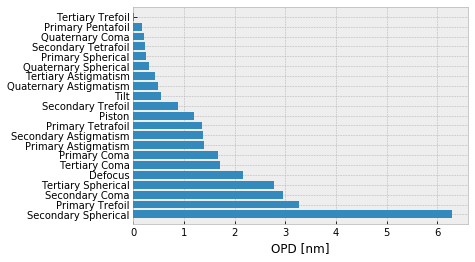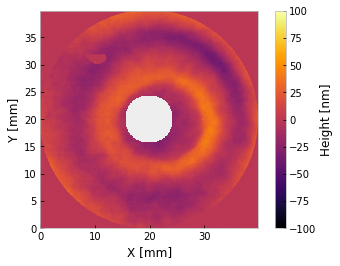Analysis of Interferometric Wavefront Data¶
In this example, we will see how to use prysm to almost entirely supplant the software that comes with a commerical interferometer to analyze the wavefront of an optic. We begin by importing the relevant classes and setting some aesthetics for matplotlib.
[1]:
from prysm import Interferogram, FringeZernike, sample_files, zernikefit
from matplotlib import pyplot as plt
plt.style.use('bmh')
We point prysm to the file, create a new interferogram, mask it to a circular region 100 mm across, subtract piston, tip/tilt and power, and evalute the PV and RMS wavefront error. We also plot the wavefront to make sure all has gone well
[2]:
p = sample_files('dat') # sample Zygo .dat file, will be downloaded on demand and saved locally
i = Interferogram.from_zygo_dat(p)
i.crop().mask('circle', 40).crop()
i.remove_piston_tiptilt_power()
print(i.pv, i.rms)
i.plot2d(clim=100, interp_method='bilinear') # +/- 100 nm
plt.grid(False)
83.33634959318245 15.245987053549815

The interferogram is cropped twice – once to enclose the valid data, then again to apply a mask centered on that region. For relatively conventional interferometry, you may want to stop here. If you want to use a different unit, that is easy enough,
[3]:
i.change_phase_unit('waves')
1/i.pv, 1/i.rms # print reciprocal -- "one over xxx waves"
[3]:
(7.593324934352549, 41.50600279806053)
There is no need to crop again since the outer bound has not changed. Perhaps you wish to evaluated the RMS within the 1 - 10 mm spatial periods,
[4]:
i.change_phase_unit('nm')
i.fill()
i.bandlimited_rms(1,10)
[4]:
4.440527609280636
This value is derived from the PSD, so you must call fill first. Do not worry about the corners of the array containing data - it will be windowed out. If you do this on a part which has a central obscuration, the result will be incorrect. Otherwise, the value tends to agree to within +/- 5% of Zygo’s Mx ® software, though the authors of prysm do not believe they are calculated at all the same way.
If you wish to decompose the wavefront into Zernike polynomials, that is easy enough.
[5]:
# do this on data which has not been filled to avoid errors introduced by the fill value.
coefficients = zernikefit(i.phase, terms=36, norm=True, map_='fringe')
fz = FringeZernike(coefficients, dia=i.diameter, opd_unit=i.phase_unit, norm=True)
fz
[5]:
<prysm.zernike.FringeZernike at 0x7fb499db40b8>
This print might be a bit daunting, one may prefer to see the top few terms by magnitude,
[6]:
fz.top_n(5)
[6]:
[(6.296543, 16, 'Secondary Spherical'),
(3.035946, 10, 'Primary Trefoil Y'),
(-2.779492, 25, 'Tertiary Spherical'),
(2.38442, 14, 'Secondary Coma Y'),
(-2.171752, 4, 'Defocus')]
or a barplot of all terms,
[7]:
fz.barplot_magnitudes(orientation='v', sort=True)
[7]:
(<Figure size 432x288 with 1 Axes>,
<matplotlib.axes._subplots.AxesSubplot at 0x7fb499db49e8>)

The sample data has a ciruclar clear aperture, but if it had a central obscuration (such as transmitted wavefront data for a telescope) that would be easy to mask too. PSD, and by extension bandlimited RMS values for data with annular support will be nonsensical.
[8]:
i.mask('invertedcircle', 7)
i.plot2d(clim=100) # +/- 100 nm
plt.grid(False)

[ ]: